On September 25, Dr. Bob and Laura Cortner spoke from the CityLit Stage at the 2016 Baltimore Book Fest on their book The Secret Life of Lady Liberty: Goddess in the New World. We had a full house!
Photo Gallery
Click thumbnails to enlarge.
On September 25, Dr. Bob and Laura Cortner spoke from the CityLit Stage at the 2016 Baltimore Book Fest on their book The Secret Life of Lady Liberty: Goddess in the New World. We had a full house!
Click thumbnails to enlarge.
In some ways, Akasha is the culmination of Hieronimus’s series of instructive, esoteric, symbolic paintings from the late 1960s and early 1970s. Commissioned by his musician friend Bob Grimm for his album of the same name, this design features many of the same elements in previous works, but this time the purposes of the Beings are more certain and further along in their development.
The concept of akasha is used in several Eastern traditions to describe the spiritual essence that pervades the universe, or that interconnecting “something” often compared to the ether. According to Helena Blavatsky, however, this primordial substance “is to Ether what Spirit is to Matter.” In other words, it is the “Universal Space in which lies inherent the eternal Ideation of the Universe.”
Akasha represents the magnum opus for Grimm, and with music and lyrics just as deep and resonant as the themes in Hieronimus’s artwork, the two were a perfect match. The album is light years ahead of its time, and has recently been remastered and made available on CD at www.BobGrimm.net. Hieronimus believes that sound is the translated symbol of Logos — or “Speech” in its mystic sense, as Blavatsky called it — and that the music on this album is both healing and transformative.
To depict this he started in the top right corner with the figure of Aquarius pouring its altruistic energies onto the top of the Great Pyramid where a ritual is being performed. At the bottom of the pyramid is a door with the word Akasha written above it. On the door is a cross with a rose in the center, the symbol of the Rosicrucians, a secret society focused on healing. Two angelic Beings from the Mystery School of Initiation, one yellow (the mind) and one pink (the heart) are holding a scroll and inscribing upon it the message “Man Know Thyself. Presume not God to Scan. The Proper Study of Mankind is Man.” In other words, look within to find the God self. Over them hovers the white capstone bearing eyes to show the all-seeing capability of the God within. The Great Pyramid or temple below is colored in rainbows, a symbol of the higher mental plane and a bridge between the higher and lower natures (heaven and earth). The rainbow as the bridge of heaven is also seen in several other places, flowing out of the pyramid, surrounding the eyes in the triangle, and in the wings of Pegasus.
From this ritual emanate four horses dominating the left side of the painting, which was used as the back of the album cover. The higher symbolic aspect of the horse is the intellect, and the winged-horse, or Pegasus, symbolizes the soaring power of natural forces, or the innate capacity for spiritualization. The three riders are each holding a flag and represent the evolution of consciousness manifesting in various nations. The top yellow figure on a purple horse carries the flag of Great Britain and is looking backwards toward their flag and the capstone above the pyramid temple. Below Great Britain is a green Being holding the American flag riding upon a violet horse. In America’s right hand is held an ankh, symbolizing life. Even though America’s horse is in front and just behind Pegasus, the Russian flag of the third Being is out in front indicating that Russia is advancing rapidly. Russia is a pink Being riding a yellow horse.
All five Beings in this piece have swirling energy fields in and around their neck and head regions. These energy fields are activated chakras, which correspond to various spiritual powers. The recording angels at the pyramid have activated chakras at the rear of their heads (the 6th chakra), as does Great Britain. Russia’s chakra is at its throat (5th chakra), while America’s chakra is at the top of its forehead (7th chakra). Above Pegasus’s head is a swirling galaxy indicating Pegasus is a higher dimensional Being which inverts all evil into good.
The Akasha album cover story says that although America is presently at the forefront in our movement toward one people, one planet, Russia is in the process of great growth. In the future generations, Russia may take America’s place. Great Britain was also once at the forefront, but is now looking backward and focused on its past. Over the millennia each continent and nation makes major contributions to planetary consciousness, but in the distant future of the Aquarian age, we will view ourselves as One People on One Planet, or world citizens.
We the People is Dr. Bob Heironimous’s most recent moving mural. Originally painted in 2006, and restored in 2008 We the People uses portraits and symbols to share the message of unity in the United States. In addition to many of the nation’s widely recognized Founding Fathers featured on the car, it also highlights the League of the Iroquois Indians and their oft-hidden influence on the nation’s government.
We the People originated as the Founding Fathers, a hand-painted mural with a 1983 Mercedes Sedan as a canvas. Founding Fathers was a visual expression of Dr. Herionimous’s book entitled “Founding Fathers, Secret Societies.”[LINK] Debuting in 2006, Founding Fathers was Dr. Herionimous’s first painted car in over 20 years and was completed in 3 months. It debuted at the acclaimed outsider art museum in Baltimore, the American Visionary Art Museum (AVAM) that Spring. In November, it became the first and only biodiesel art car thanks to the help of volunteers at the Baltimore Biodiesel Co-op.
The symbology featured on Founding Fathers showcases the lesser-known influences on our founders as read through our nation’s symbols of flags and great seals. Particularly highlighted are the hidden influences of the League of the Iroquois Indians on our nation’s form of government. Hieronimus detailed this in Founding Fathers, Secret Societies and the same theme can be seen in the We the People mural on St Paul St. in Baltimore.
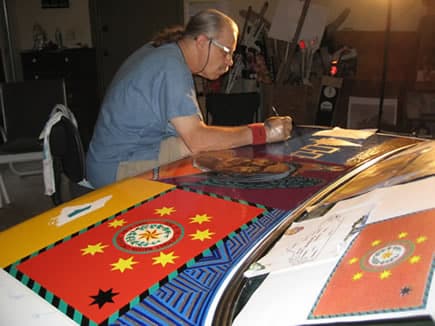
In the summer of 2008, Founding Fathers experienced a great deal of damage due to a rear-end accident. Over two-thirds of the car had to be redesigned making it a completely new art piece. Due to a collaborative effort, the restoration and redesign were completed in only three weeks. The spirit of artists coming together to complete the task helped to inspire the new theme and name; We the People.
The new design explains the definition of E Pluribus Unum, or “Out of many, one,” and how the American people can achieve success through unity and collaboration. Some of the updated imagery includes a depiction of Benjamin Bannker on the passenger side door, the Statue of Liberty looking over Dr. Herionimous’s famous Light bus, and a large eagle holding the message of E Pluribus Unum on the roof.
To invite We the People to be part of your parade or festival, email radio@21stcenturyradio.com.
You can also find We the People merchandise (including the mini standee pictured right) in the H&Co Store.
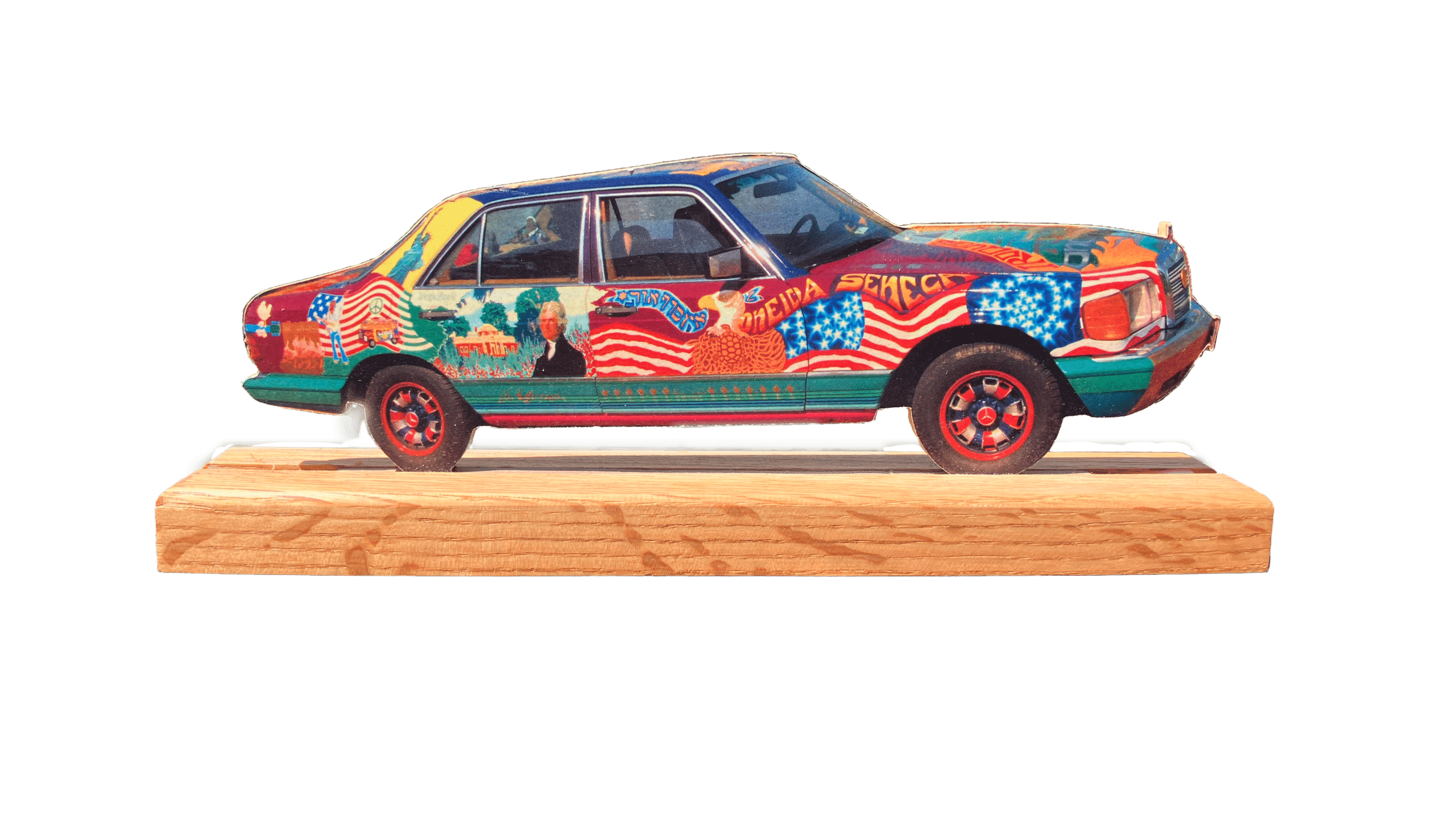
In 1968, Bob Hieronimus spent a memorable summer visiting backstage with artists like Jimi Hendrix, Janis Joplin, and Elektra Records artists, including The Doors. These artists, among others, expressed a desire for more information on esoterica and welcomed Bob as someone to share valuable information with. While backstage, Bob discussed earth changes, astrology, Atlantis, reincarnation, meditation, and UFOs – the same material he and Dr. Zohara later brought to the airwaves in the eighties.
Simultaneously, “psychedelic” painted cars were growing in popularity. Bob had already postponed a mural commission at Johns Hopkins University to embark on his and now began receiving commissions for artcars too. When he returned home, Bob began work on the “Light” Bus, a commission for friend and musician Bob Grimm. Little did he know it would arguably become his most well-known artwork, thanks to an AP Photographer who documented it at the legendary 1969 Woodstock Music and Art Fair.
Bob Grimm played guitar in the Baltimore band “Light.” They too had spent many nights with Bob backstage, where he shared the “Light” meditation with them. They would practice the meditation before gigs to better attune to themselves, each other, and the audience and found it vastly improved their band’s synchronicity. The bus served as a way to visualize the information Bob shared with them – the importance of aligning our intentions with the divine plan, coming together as a human community, and planting seeds of goodwill through our actions and behavior. Over time, this message was distilled into a mantra: Prayer, Meditation, Service.
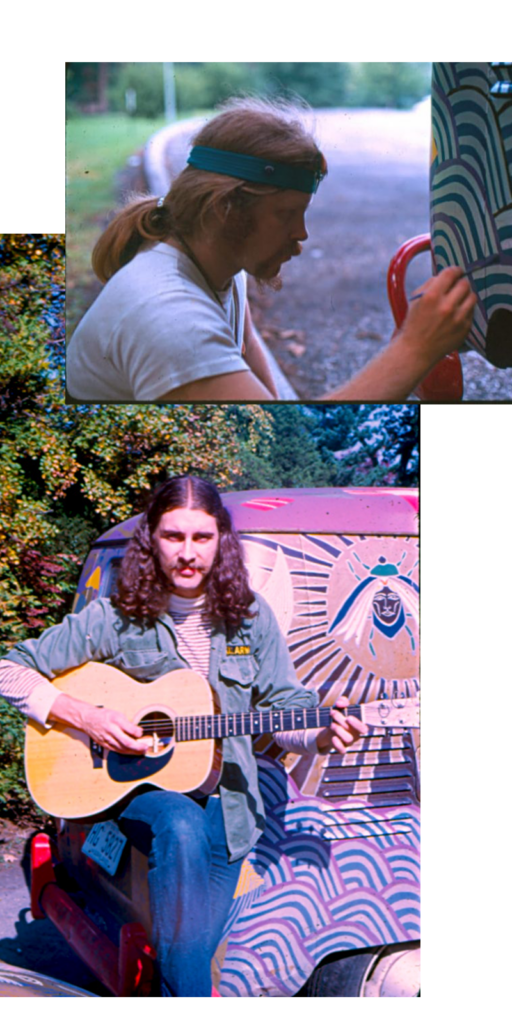
Like all of Bob’s murals, the bus features a vibrant, visceral color palette, ancient symbology from multiple esoteric traditions, winding wavy lines to connote the natural vibrations of the universe. Carefully chosen, simple yet potent language (“Pray,” “S/He is coming”) appears on the bus, anticipating the evolution of humankind.
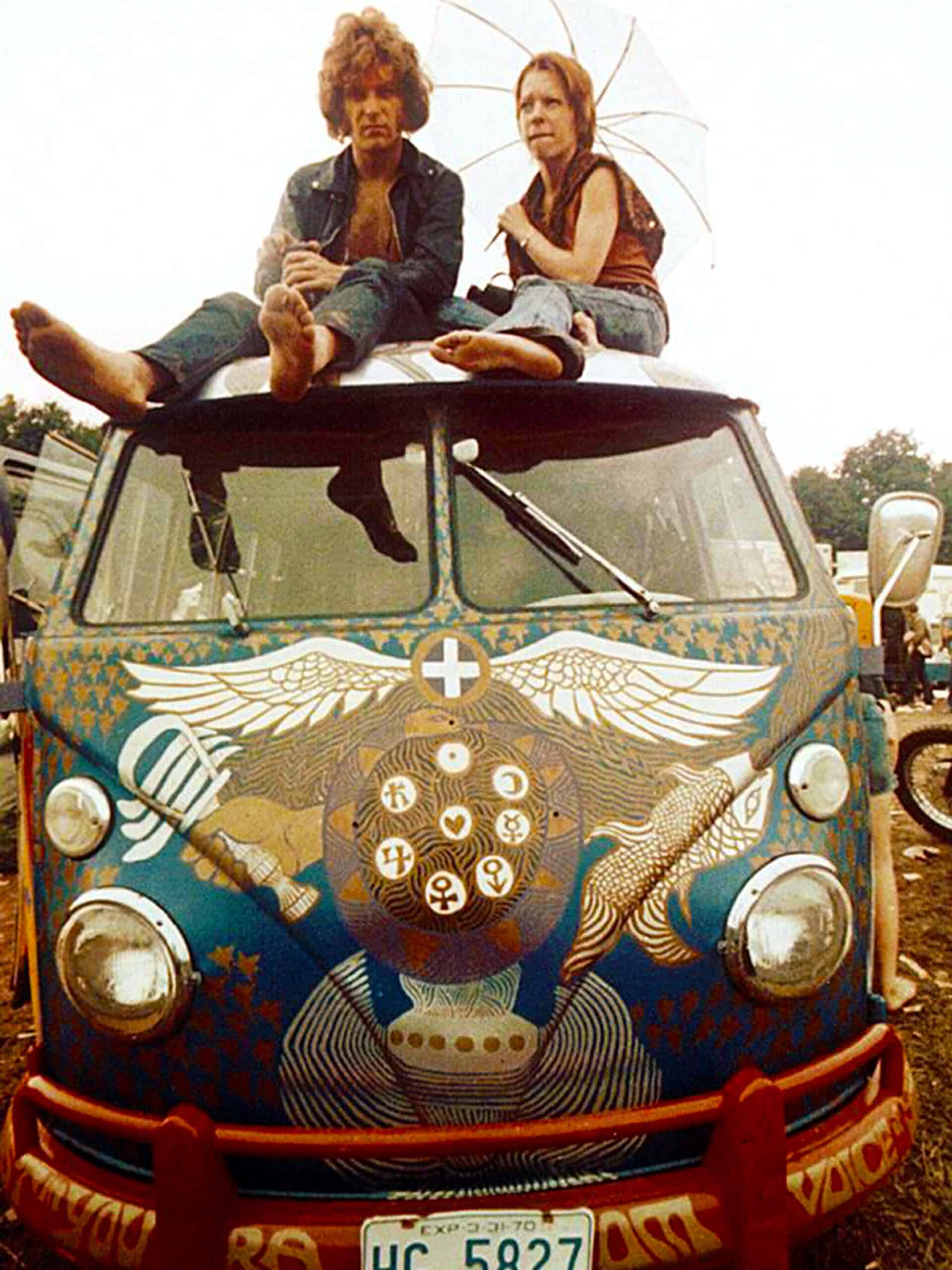
Most recognized is the front side of the bus, which features the iconic Volkswagen bus silhouette, splashed with a gold and silver symbolic story. As Bob describes it, the nutshell version of the story is “As we enter the age of Aquarius, humanity will once again become conscious of the builders and hierarchies of the universe by aligning ourselves with the divine plan through cosmic vibration.”
The front of the bus features a galaxy of stars, the Milky Way, the birthplace of life in the universe. Just below is a pair of wings (spirit) surmounting a circled cross related to the four builders of the universe air, earth, fire, and water. Below this is the serpent biting its tail, representing eternity. Inside are eight circles containing seven cosmic symbols: Sun (spiritual self), Saturn (karma), Jupiter (expansion of consciousness), Venus (harmony), Mars (action), Mercury (mind), and Moon (personality). The central circle is the heart: the cohesive force of the universe, Love.
For a full analysis of the symbology of the Light Bus, note that all Light Bus related products in the Store come with a symbology guide and additional Woodstock-related gifts.
In 2016, a filmmaker by the name of John Wesley Chisholm contacted Hieronimus to propose a documentary featuring the Light Bus. The project led to a hunt for a VW bus that matched the original and a full restoration process. The new LIGHT debuted in 2019 at the Orange County Transporter Organization (O.C.T.O.) Winter Meet in California and was a hit with Volkswagen enthusiasts.
This began a fruitful collaborative relationship with Volkswagen, leading to the creation of the 2023 “Love the Earth” bus and a subsequent line of Dr. Bob for VW DriverGear merchandise, debuting in 2024.

Currently, the Light Bus can be seen around the country at art exhibits, museums, and Volkswagen events. Follow Hieronimus and Co. on social media for updates!
In 2006, Baltimore’s Jewish Community Center invited Bob Hieroinmus to participate in a show titled “Of Doors and Keys.” The end result was Perennial Philosophy. The 17″ x 17″ piece combined symbols of dominant religions in Europe/the United States to show how they are all keys to unlock the truth of “One People, One Planet.”
A perennial philosophy suggests universal truths and principles indigenous to all peoples and cultures. People across time recorded their perceptions about the nature of reality. At their roots, these perceptions are more similar than different. A simplified analysis and interpretation of this piece demonstrates deep similarities between these three sacred symbols: the Star of David, the cross, and the crescent and star.
Aldous Huxley noted in his 1944 book, The Perennial Philosophy, that the term philosophia perennis was popularized by the 17th century philosopher, Gottfried Leibniz. Huxley updated the definition to read: “the metaphysic that recognizes a divine Reality substantial to the world of things and lives and minds; the psychology that finds in the soul something similar to, or even identical with, divine Reality; the ethic that places man’s final end in the knowledge of the immanent and transcendent Ground of all being; the thing is immemorial and universal. Rudiments of the perennial philosophy may be found among the traditional lore of primitive peoples in every region of the world, and in its fully developed forms it has a place in every one of the higher religions.”
To read more about the symbolism of this painting, see the One People, One Planet, Hon! guide, available in the store.
With A Little Help From My Friends was originally painted in 1996 by Dr. Bob Hieronimus and with the help of artists Katie Butler, Lyle Kissack, and Gerald Ross. The mural showcases portraits of icons known for their humanitarianism, creativity, and talent including Gandhi, Martin Luther King, Jr., Bob Marley, Harriet Tubman, and Bob Dylan, among others. The entire mural was completed in only 17 days and was awarded “Best Mural” by local Baltimore television station WMAR-TV. The dedication ceremony for the mural was attended by several heroes and dignitaries including Rachel Carson’s grandson, China democracy advocate Liu Gang, and Hall of Famer Leon Day’s widow, Geraldine. The mural was also visited several times by Ziggy and Stephen Marley, sons of Bob Marley, in 1996 and 1997.
In 2008, Baltimore, MD was one of four cities chosen to participate in the Home and Garden Television Network’s (HGTV) “Save the World, Start at Home” initiative. This initiative would include the restoration of several projects around the city with the help of talent and crew from HGTV, volunteers, and support from companies such as Rebuilding Together, National Trust for Historic Preservation and the Natural Resources Defense Council. With an invitation from Baltimore Green Construction and Rebuilding Together Baltimore, Dr. Hieronimus and his crew of artists and assistants began to restore the original 1996 mural.
The sponsoring organizations were also funding renovations on the Mediation Center building including energy efficient doors, windows, and a green roof. This posed a challenge for the mural restoration crew as well as the parts of the mural that were too damaged to simply paint over, requiring the bricks to be demolished and re-cemented. Out of the 17 days of the process, it rained 11. The crew remained steadfast though and completed the restored piece in May of 2008.
To see With A Little Help From Our Friends in person, visit the Baltimore Community Mediation Center at 3333 Greenmount Ave.
St. Paul St. Park is home to the We the People mural by Dr. Bob Hieronimus. It is a redesign of his Bicentennial mural originally commissioned by the City of Baltimore and painted in 1974. The overall theme of this mural is “One People, One Planet”. The piece uses aspects of the divine feminine present in United States symbolism, plus Hieronimus’s trademark references to extraterrestrial life, astrology, and even the Yellow Submarine. The core message of the mural derives from Hieronimus’s doctoral research on indigenous influences on the structure of the United States government. Central to this message is Hieronimus’s certainty [LINK: One People One Planet] that the nation must tap into its female power and learn to lead with compassion instead of domination – a message frequently appearing in his artwork and the thesis of his 2016 book The Secret Life of Lady Liberty.
The original Bicentennial mural was one of ten contest winners for Baltimore’s Bicentennial Art Program in 1974. Bicentennial remained a landmark in St. Paul Street Park for nearly 40 years until 2013 when Hieronimus was asked to come out of mural retirement to help preserve his work.
The preservation process was made possible through funding from Zohara Meyerhoff Hieronimus, initiative from neighbors in the community, and support from Jubilee Baltimore, Midtown Development, and Guppy Management’s Alan and Mike Shecter.
To complete the task, Hieroinmus recruited a crew of dedicated art students and professionals from UMBC, MICA, and Johns Hopkins University and was able to both restore the original work, plus update and expand it to double the size of the original. The result is the fully refurbished, redesigned, and renamed We the People mural. Its vibrant color palette is hard to miss as residents and visitors alike pass the St. Paul and Lafayette intersection in Baltimore.
In the summer of 2014, the Charles North Community Association and Jubilee Baltimore organized a celebration for the recent changes to the park, recognizing the volunteers and funders, and honoring the artists with live music, and refreshments. Both Bob and Zoh Hieronimus delivered [LINK] moving speeches to commemorate the reopening of the mural.

To see We the People in person, visit St Paul Street Park at 111 E. Lafayette Street at St. Paul Street. To read more details about the symbolism used and the artists that helped to restore the mural, read We the People A Mural is Reborn, Enlarged, and Renamed. [LINK]
The second floor of Johns Hopkins Levering Hall is home to the art installation known as Apocalypse, one of the largest and most influential murals painted by Dr. Bob Hieronimus. The mural showcases a vast array of symbology and iconography not depicting the end of the world, as some might assume from the title, but the cyclical nature of all of history.
Commissioned in 1968 by Johns Hopkins Chaplain, Chester “Chet” Wickwire, the massive art piece took a total of six months for Hieronimus to complete. The finished 2,700 square-foot piece debuted in February of 1969, covering the entire hall and stairwell. It showcases rich esoteric symbology meaning including Egyptian hieroglyphics, Hebrew, Sanskrit, zodiac signs, flags, hearts, flowers, serpents, horses, and stars.
Dr. Wickwire was an early champion of Hieronimus’s iconoclastic artwork and requested that the mural live directly outside his office in Levering Hall. Students affectionately named the space “Chester’s Place” and often used it as a meeting ground. Dr. Wickwire was known for encouraging students to engage in consciousness-raising and activities like political protest, wanting students to focus their attention and energy on creating a better society. The mural served as a point of curiosity, conversation, and inspiration for those students, staff, and visitors hoping to make a positive change in the world.
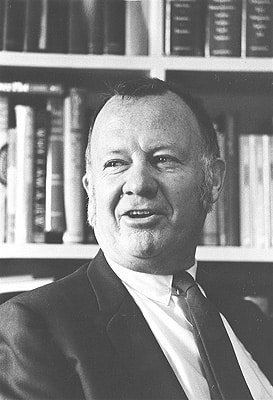
In the summer of 2015 the mural was completely restored to its original condition thanks to funding provided by Johns Hopkins University, Dr. Zohara Hieronimus and the Joseph and Harvey Meyerhoff Family Charitable Funds, and a team of artists handpicked by Dr. Bob. Johns Hopkins University enthusiastically embraced Hieronimus’s historic piece of artwork, installing new museum-style furniture, new lighting fixtures, and new protection measures to preserve the work in the future.
Current students continue to use Levering Hall as a popular meeting spot, and Apocalypse continues to spark inspiration and discussion. Ella Rogers-Fett, a Krieger School alumni and history major visited the mural for the first time in 2015. She says many of her classmates were inspired upon learning about the mural’s relationship to a history of student activism at Hopkins. That inspiration resulted in a petition to her fellow students that encouraged Hopkins to divest itself from carbon-related stocks to reduce its environmental impact.
“I like the idea that student activists of today are meeting there to advance important issues,” says Rogers-Fett, a former student who served as co-director of the student-run Sexual Assault Resource Unit. “We’re continuing the spirit of Apocalypse.”
Dr. Stuart “Bill” Leslie, historian for Johns Hopkins University, mentions the mural fondly, saying “The Apocalypse mural is a good reminder for the current crop of students that their predecessors were out there in the front lines for civil rights.”
The most complete interpretation of the Apocalypse mural is found in the 72-page bound and glossy guidebook published in 2016 in full color, complete with foldout panoramas and reproductions of the sketches and notes from the original Hieronimus journals from 1968-69, and can be purchased in the H&Co shop.
To see Apocalypse in person, visit Levering Hall at Johns Hopkins University on weekdays from 11 am-4 pm.
Dr. Bob Hieronimus, Ph.D. and Laura E. Cortner, co-authors of the forthcoming It’s All in the Mind: Inside the Yellow Submarine, were interviewed on Something About The Beatles to discuss their new research into the history of The Beatles Yellow Submarine. Listen to the interview.